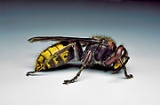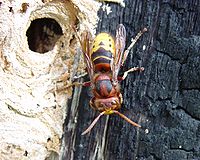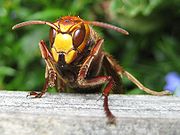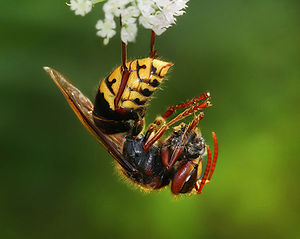
European hornet
Encyclopedia
The European hornet Vespa crabro, commonly known simply as the "hornet
", is the largest European eusocial
wasp
. The queen measures 25 to 50 mm (1–2 in) long; males and workers are smaller. In males, as in most members of the Aculeata
, the antennae
have 13 segments, while in females there are only 12; also as in other aculeates, the male abdomen
has seven visible segments, while the female has six; females possess an ovipositor
modified into a sting which is not barbed. See wasp and bee characteristics
to help identify similar insects.
This species will sting in response to being stepped on or grabbed. They are also defensive of their hive and rather aggressive around food sources such as lilac bushes. Care should be taken when encountered in these circumstances as they may sting without warning. The pain from the sting may persist for several days with attendant swelling.
 The eyes are deeply indented, shaped like a C. The wings are reddish-orange, while the petiolate
The eyes are deeply indented, shaped like a C. The wings are reddish-orange, while the petiolate
abdomen is brown striped with yellow. The European hornet is larger than the common wasp
, but smaller than some Asian hornet
species. It has hair on the thorax and abdomen, although the European hornet is not as hairy as most bee
s.
European hornets often have the rove beetle
Velleius dilatatus
living in their colonies.
 European hornets are often mischaracterised as very aggressive and dangerous, and are greatly feared by some people. Some people believe that "three stings from the European hornet can kill an adult human, and seven can kill a horse". These are common myths - a sting from a European hornet isn't any more dangerous than any other wasp sting, and European hornets are less aggressive than other wasps. In contrast, multiple Asian giant hornet
European hornets are often mischaracterised as very aggressive and dangerous, and are greatly feared by some people. Some people believe that "three stings from the European hornet can kill an adult human, and seven can kill a horse". These are common myths - a sting from a European hornet isn't any more dangerous than any other wasp sting, and European hornets are less aggressive than other wasps. In contrast, multiple Asian giant hornet
s stings are, in fact, more dangerous.
While impressive due to their size and loud sound, European hornets are in fact much less aggressive than some of their smaller relatives, such as the German wasp
and the common wasp. When approached, European hornets can actually be seen to slowly crawl backwards and eventually flee, rather than attack. This can make it hard to remove hornets from indoors, if they happen to come in through an open window or door. While not aggressive when encountered far from the nest, multiple workers will vigorously defend the nest if provoked. Nests can be approached without provocation (by moving slowly and not breathing towards the nest) to about 50 cm (19.7 in). Nests are usually not a problem outside buildings, but because they drip faeces, a bad-smelling black liquid, nests inside sheds or walls can be a problem.
, where it has been illegal to kill a European hornet or nest since 1 January 1987, with a fine of up to 50,000 Euros.
In Australia however, they represent a noxious introduced species and thrive in the warmer conditions, often reaching minor plague proportions during hot, dry summers.
or other social wasps.
branches, which results in dead branches.
 European hornets worldwide are found with geographic colour forms
European hornets worldwide are found with geographic colour forms
:
Hornet
Hornets are the largest eusocial wasps; some species can reach up to in length. The true hornets make up the genus Vespa and are distinguished from other vespines by the width of the vertex , which is proportionally larger in Vespa and by the anteriorly rounded gasters .- Life cycle :In...
", is the largest European eusocial
Eusociality
Eusociality is a term used for the highest level of social organization in a hierarchical classification....
wasp
Wasp
The term wasp is typically defined as any insect of the order Hymenoptera and suborder Apocrita that is neither a bee nor an ant. Almost every pest insect species has at least one wasp species that preys upon it or parasitizes it, making wasps critically important in natural control of their...
. The queen measures 25 to 50 mm (1–2 in) long; males and workers are smaller. In males, as in most members of the Aculeata
Aculeata
The name Aculeata is used to refer to a monophyletic lineage of Hymenoptera. The word "Aculeata" is a reference to the defining feature of the group, which is the modification of the ovipositor into a stinger . In other words, the structure that was originally used to lay eggs is modified instead...
, the antennae
Antenna (biology)
Antennae in biology have historically been paired appendages used for sensing in arthropods. More recently, the term has also been applied to cilium structures present in most cell types of eukaryotes....
have 13 segments, while in females there are only 12; also as in other aculeates, the male abdomen
Abdomen
In vertebrates such as mammals the abdomen constitutes the part of the body between the thorax and pelvis. The region enclosed by the abdomen is termed the abdominal cavity...
has seven visible segments, while the female has six; females possess an ovipositor
Ovipositor
The ovipositor is an organ used by some animals for oviposition, i.e., the laying of eggs. It consists of a maximum of three pairs of appendages formed to transmit the egg, to prepare a place for it, and to place it properly...
modified into a sting which is not barbed. See wasp and bee characteristics
Characteristics of common wasps and bees
While easily confused at a distance or without close observation, there are many different characteristics of common large bees and wasps which can be used to identify them.-External links:* * *...
to help identify similar insects.
This species will sting in response to being stepped on or grabbed. They are also defensive of their hive and rather aggressive around food sources such as lilac bushes. Care should be taken when encountered in these circumstances as they may sting without warning. The pain from the sting may persist for several days with attendant swelling.
Description

Petiole (insect)
In entomology, the term petiole is most commonly used to refer to the constricted first metasomal segment of members of the Hymenopteran suborder Apocrita; it may be used to refer to other insects with similar body shapes, where the metasomal base is constricted...
abdomen is brown striped with yellow. The European hornet is larger than the common wasp
Common wasp
The common wasp, Vespula vulgaris, known in the US as the yellowjacket, is found in much of the Northern Hemisphere and has been introduced to Australia and New Zealand. It is a eusocial vespid which builds its grey paper nest in or on a structure capable of supporting it...
, but smaller than some Asian hornet
Asian giant hornet
The Asian giant hornet , including the subspecies Japanese giant hornet , colloquially known as the yak-killer hornet, is the world's largest hornet, native to temperate and tropical Eastern Asia...
species. It has hair on the thorax and abdomen, although the European hornet is not as hairy as most bee
Bee
Bees are flying insects closely related to wasps and ants, and are known for their role in pollination and for producing honey and beeswax. Bees are a monophyletic lineage within the superfamily Apoidea, presently classified by the unranked taxon name Anthophila...
s.
European hornets often have the rove beetle
Rove beetle
The rove beetles are a large family of beetles, primarily distinguished by their short elytra that leave more than half of their abdomens exposed. With over 46,000 species in thousands of genera, the group is the second largest family of beetles after the Curculionidae...
Velleius dilatatus
Velleius dilatatus
The rove beetle Velleius dilatatus lives together with the European hornet Vespa crabro crabro.Velleius dilatatus is up to 26 mm long. It feeds on detritus produced by the hornets . The beetles cannot survive without the hornets themselves, even if there is enough detritus present.It finds...
living in their colonies.
Urban legends

Asian giant hornet
The Asian giant hornet , including the subspecies Japanese giant hornet , colloquially known as the yak-killer hornet, is the world's largest hornet, native to temperate and tropical Eastern Asia...
s stings are, in fact, more dangerous.
While impressive due to their size and loud sound, European hornets are in fact much less aggressive than some of their smaller relatives, such as the German wasp
German wasp
The German wasp, or European wasp, Vespula germanica, is a wasp found in much of the Northern Hemisphere, native to Europe, northern Africa, and temperate Asia. It has been introduced and is well-established in many other places, including North America, South America , Australia and New Zealand...
and the common wasp. When approached, European hornets can actually be seen to slowly crawl backwards and eventually flee, rather than attack. This can make it hard to remove hornets from indoors, if they happen to come in through an open window or door. While not aggressive when encountered far from the nest, multiple workers will vigorously defend the nest if provoked. Nests can be approached without provocation (by moving slowly and not breathing towards the nest) to about 50 cm (19.7 in). Nests are usually not a problem outside buildings, but because they drip faeces, a bad-smelling black liquid, nests inside sheds or walls can be a problem.
Endangered species and legal protection
Unwarranted fear has often led to the destruction of nests, leading to the decline of the species, which is often locally threatened or even endangered. European hornets benefit from legal protection in some countries, notably GermanyGermany
Germany , officially the Federal Republic of Germany , is a federal parliamentary republic in Europe. The country consists of 16 states while the capital and largest city is Berlin. Germany covers an area of 357,021 km2 and has a largely temperate seasonal climate...
, where it has been illegal to kill a European hornet or nest since 1 January 1987, with a fine of up to 50,000 Euros.
In Australia however, they represent a noxious introduced species and thrive in the warmer conditions, often reaching minor plague proportions during hot, dry summers.
Attraction to lights and food
European hornets are attracted to lights at night, but are not attracted to human foods and food wastes. However, they can totally destroy fruits, such as apples, while the fruit is still on the tree. This is quite unlike the bald-faced hornetBald-faced hornet
Dolichovespula maculata is a North American insect commonly called the bald-faced hornet...
or other social wasps.
Problems associated
European hornets are carnivores and eat many species of insects. Many of these insects are considered pests in the garden, which indicates that the hornet provides a benefit to the average garden/farm. For this reason it is suggested that you do not attempt to kill the hive. However, they are known to eradicate domestic honeybee hives, resulting in fewer honeybees for open pollination. They also tend to girdleGirdling
Girdling, also called ring barking or ring-barking, is the complete removal of a strip of bark from around the entire circumference of either a branch or trunk of a woody plant. Girdling results in the death of wood tissues beyond the damage...
branches, which results in dead branches.
Geographic colour forms

Form (botany)
In botanical nomenclature, a form is one of the "secondary" taxonomic ranks, below that of variety, which in turn is below that of species; it is an infraspecific taxon...
:
- Vespa crabro crabro Linnaeus, 1758
- Vespa crabro vexator Harris, 1776. A European hornet found in southern counties of England, and continental Europe. This subspecies can be distinguished from the Common European hornet as V. crabro vexator has a yellow head.
- Vespa crabro germana Christ, 1791
- Vespa crabro crabroniformis Smith, 1852
- Vespa crabro borealis Radoszkowski, 1863
- Vespa crabro oberthuri du Buysson, 1902
- Vespa crabro flavofasciata Cameron, 1903
- Vespa crabro altaica Pérez, 1910
- Vespa crabro caspica Pérez, 1910
- Vespa crabro chinensis Birula, 1925

